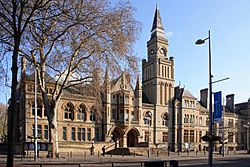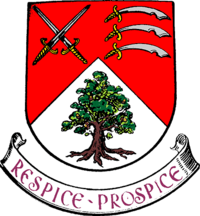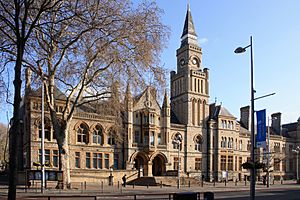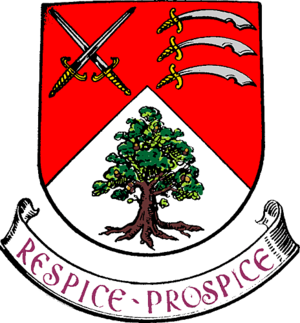Municipal Borough of Ealing facts for kids
| Ealing | |
| Motto: Respice Prospice (Look backward, look forward) | |
 Ealing Town Hall |
|
 Ealing within Middlesex in 1961 |
|
| Geography | |
| Status | Local board of health 1863 - 1894 Urban district 1894 - 1901 Municipal borough 1901 - 1965 |
| 1894 area | 2,947 acres (11.9 km2) |
| 1965 area | 8,783 acres (35.5 km2) |
| HQ | Ealing |
| History | |
| Created | 1863 |
| Abolished | 1965 |
| Succeeded by | London Borough of Ealing |
Quick facts for kids Demography |
|
|---|---|
| 1901 population | 33,031 |
| 1961 population | 183,077 |
 |
|
Ealing was a special area that managed its own local government for over 100 years. It existed from 1863 to 1965. This area was located around the town of Ealing in Middlesex.
For a long time, Ealing was part of the growing city of London. In 1965, it officially became part of Greater London. Today, its former area is part of the larger London Borough of Ealing.
Contents
Ealing's Journey: A History of Local Government
This section explores how the Ealing area was governed over the years. It changed from a small local board to a larger borough.
Early Days: The Local Board of Health
In 1863, a "local board of health" was created for the southern part of Ealing. This board was like a small council. Its job was to look after public health matters. This included things like clean water and waste removal.
By 1873, the board's area grew. It then covered the entire parish of Ealing. This meant more people were looked after by the board.
Becoming an Urban District
In 1894, Ealing became an "urban district." This change happened because of a law called the Local Government Act 1894. An urban district had more powers than a local board. It could manage more services for the community.
Ealing Becomes a Municipal Borough
Ealing took another big step in 1901. It was given a special "charter of incorporation." This made it the very first "municipal borough" in Middlesex. A municipal borough was like a town with its own official government.
The urban district council was replaced by a new group. This group was called a corporation. It included a mayor, 6 aldermen, and 18 councillors. These people were chosen to lead the borough.
The Ealing Town Hall was built in 1886. It replaced an older building on the same spot. The architect, Charles Jones, designed it. He also designed other important buildings in the area.
Growing Bigger: More Areas Join Ealing
Ealing borough grew much larger in 1926. It welcomed two nearby urban districts. These were Greenford and Hanwell. Greenford also included the areas of Perivale and West Twyford.
Because of this growth, the borough council also got bigger. By 1960, it had a mayor, 16 aldermen, and 48 councillors. This shows how much Ealing had expanded.
In 1952, there was an attempt to make Ealing a "county borough." This would have given it even more independence. However, this attempt was not successful.
The End of the Municipal Borough
In 1965, a new law changed local government in London. This was the London Government Act 1963. Because of this law, the municipal borough of Ealing was officially ended.
Its area was then combined with two other boroughs. These were the Municipal Borough of Acton and the Municipal Borough of Southall. Together, they formed the new London Borough of Ealing that exists today.
Ealing's Coat of Arms
A coat of arms is a special design that represents a place or family. The Municipal Borough of Ealing was given its own coat of arms on February 22, 1902. This is different from the coat of arms used by the modern London Borough of Ealing.
The design of Ealing's old coat of arms had several symbols:
- Crossed Swords: These represent Saint Paul. They were taken from the arms of the Diocese of London. This shows Ealing's historical connection to the church.
- Saxon Swords (Seaxes): These are from the coat of arms of Middlesex county. They show that Ealing was part of Middlesex.
- Oak Tree: An uprooted oak tree was also part of the design. This tree was a symbol. It meant that Ealing was growing and becoming stronger.
See also
- Local Government Act 1894
- London Government Act 1963



